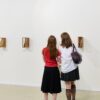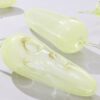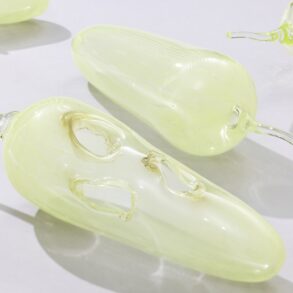Audrey Flack, a New York artist who leaped from abstract expressionism to photorealism to large-scale sculpture, exploring the varied experiences of women while drawing inspiration from Greek mythology, a Spanish Madonna and the tchotchkes and tea cups that give shape to daily life, died June 28 at a hospital in Southampton, N.Y. She was 93.
The cause was complications from an aortic tear, said her daughter Hannah Marcus.
Ms. Flack, the daughter of Jewish immigrants from Eastern Europe, spent most of her seven-decade career swimming against the art-world tide. She embraced realist painting when abstraction was in vogue, wielded an airbrush when fellow artists considered the commercial tool “immoral,” and helped define the photorealist movement in the late 1960s and ’70s, when she was the only prominent woman in a group of painters that included Chuck Close, Robert Bechtle and Richard Estes.
By the early ’80s, she had set her brushes aside to make bronze and clay sculptures, often taking her subject matter from ancient myth. Out of her studio came a procession of heroic Athenas, Daphnes and Medusas, whom she sculpted while seeking to offer an alternative to the classical depictions of men she saw in public parks and plazas.
“Beautiful, powerful women have to be out there,” she argued, “instead of generals on horses.”
Ms. Flack started out as an abstract expressionist, slinging paint onto canvases from her studio on Eighth Street in Manhattan, where a condemned building offered broken banisters but cheap rent.
The mid-century art world was electrifying, she recalled, but sexism and harassment were pervasive: By her account, abstract painter Josef Albers made a pass at her when she was one of his students at Yale, and Jackson Pollock drunkenly propositioned her one night at the Cedar Tavern, the Greenwich Village hangout where she mingled with Willem de Kooning and Franz Kline.
Partly because of all the debauchery, she left abstract expressionism behind, finding material from photographs and news clippings while embracing more figurative work. She frequently painted her family, even as she struggled to reconcile her artistic career with her life as a mother, raising two young daughters (one autistic and nonverbal) and grappling with an early marriage she described as abusive.
At the time, it was “almost radical to say you could be a mother, to talk about your children,” she told the New Yorker in 2021. She added that when a curator asked to see some of her paintings, she hustled to get her children out of her 104th Street apartment, where the dining room doubled as a studio. “I ran around the house putting clothes, diapers, everything away. Any sign that I had a child had to be erased.”
The visit was a success: One of the pictures the curator spotted, a 1964 piece showing a smiling President John F. Kennedy, moments before he was assassinated in Dallas, was selected for a group show advertising “Six Women Artists.” Ms. Flack said she was late to the opening because she had to fulfill one of her maternal duties: unclogging the toilet, which one of her daughters had stuffed with “diapers, a bunch of wooden blocks, and a wad of Play-Doh.”
By the early 1970s, Ms. Flack had developed a meticulous approach to painting, in which she arranged objects in her studios, took a photograph and projected the resulting image onto a large canvas, sometimes eight-feet square, where she would apply brightly colored paint with an air brush.
While other photorealists painted sleek cars and city streets, Ms. Flack crafted allegorical tableau that incorporated depictions of Buddha, Marilyn Monroe, strawberry tarts and even Buchenwald survivors. Her “Vanitas” series, which invoked a Baroque genre suggesting the transience of life, was filled with carefully arranged objects offering a reminder that existence was fleeting: watches, skulls, burning candles.
Some critics found her work kitschy and oversentimental, lamenting paintings like the “Macarena of Miracles” (1971), one in a series of unironic works that reinterpreted a statue of the weeping Madonna that Ms. Flack had encountered while traveling through Spain.
Assessing the state of realist painting in 1976, New York Times art critic Hilton Kramer called Ms. Flack “one of the brassiest of the new breed … the Barbra Streisand of photorealism,” adding that her work was “distinguishable from advertising art only to the extent that the product being advertised is the artist herself.”
Ms. Flack called Kramer’s criticism a “dagger to the heart.” But she continued working unabated, and found a home for her pieces in the permanent collections of institutions including the Smithsonian American Art Museum in Washington and the Museum of Modern Art and Solomon R. Guggenheim Museum in New York.
“Audrey has always been 20 years ahead of the pack,” gallerist Louis K. Meisel, who represented her at the time, told the Times in 1992. “Her work has nothing to do with the avant-garde. It’s better.”
Ms. Flack described art-making as a compulsion, a way to clarify and explore the world around her or to get out of a personal rut. She said she emerged from a two-year depression in the early 1980s, when she would sit for hours on a park bench in Manhattan, by turning from painting to sculpture. She was still experimenting at the end of her life, painting a new series that she called “Post-Pop Baroque,” and which was unveiled at New York’s Hollis Taggart gallery in March. The show coincided with the release of her memoir, “With Darkness Came Stars,” which brought her further late-in-life attention.
“Titian made art into his late 80s, and I’m now past that,” she told Smithsonian Magazine a few years ago, just after she turned 90. “I always wanted to paint like an old master, or rather an old mistress — a radical contemporary old mistress.”
The younger of two children, Audrey Lenora Flack was born in Brooklyn on May 30, 1931, and grew up in the Washington Heights section of Manhattan. Her father ran a garment factory. In her memoir, Ms. Flack described her mother as “a larger-than-life gambling addict.”
“Ironically, my mother had strong artistic abilities, yet failed to value them in herself or in me,” Ms. Flack wrote. “She embroidered tablecloths, crocheted blankets, designed her own needlepoint pillows, and set up carefully arranged flowers. She cut reproductions of Old Master paintings from magazines and placed them all over the apartment.”
The pictures ignited her interest in art. Ms. Flack went on to study at the High School of Music & Art and graduated in 1951 from Cooper Union in Manhattan. The next year, she received a BFA from Yale University.
Early in her career, Ms. Flack taught anatomy at New York University and led drawing and painting classes at Pratt Institute in Brooklyn and the School of Visual Arts in New York. Teaching helped pay the bills: For a time, she said, she was so poor that she paid her obstetrician in paintings, trading one of her still lifes for her daughter’s delivery.
Her first marriage, to Frank Levy, ended in divorce. In 1970, she married H. Robert Marcus, a copper-trading executive who advocated for people with autism and developmental disabilities. He “saved my life; he saved my kid’s,” Ms. Flack told the publication Curbed.
Her husband died May 10 at 95. Survivors include two children from her first marriage, Melissa and Hannah Marcus; two stepchildren, Mitchell and Leslie Marcus; four grandchildren; and two great-grandchildren. Another stepdaughter, Aileen Marcus, died in 2022.
One of Ms. Flack’s most ambitious projects was never completed. For more than six years, she worked on a bronze sculpture of Catherine of Braganza, the 17th-century Portuguese princess who married King Charles II of England and, by many accounts, was honored in the naming of the New York borough of Queens.
The final version of the sculpture was to stand five-stories high, clad in jewels and gold leaf, in the Hunters Point section of Queens, where it would gaze across the East River at the U.N. headquarters.
Donors secured almost $2 million in financing for the project, which stalled out in 1998 after critics questioned the appropriateness of a memorial for a monarch linked to the transatlantic slave trade, on a site overlooking a Revolutionary War battleground.
Ms. Flack, who won a design competition to make the sculpture, had a different view of the queen. She saw Catherine as “a powerful and positive image of a surviving female,” she told the Times, noting that the monarch had little choice in the marriage, a political alliance that left her with a philandering husband. Ms. Flack added that she had sought to offer an alternative to classical depictions of femininity, giving Catherine multiracial features that she refined through repeated trial and error, making as many as 100 versions of her subject’s face.
“I wanted,” she said, “to create the face of the new millennium.”
This post was originally published on this site be sure to check out more of their content







